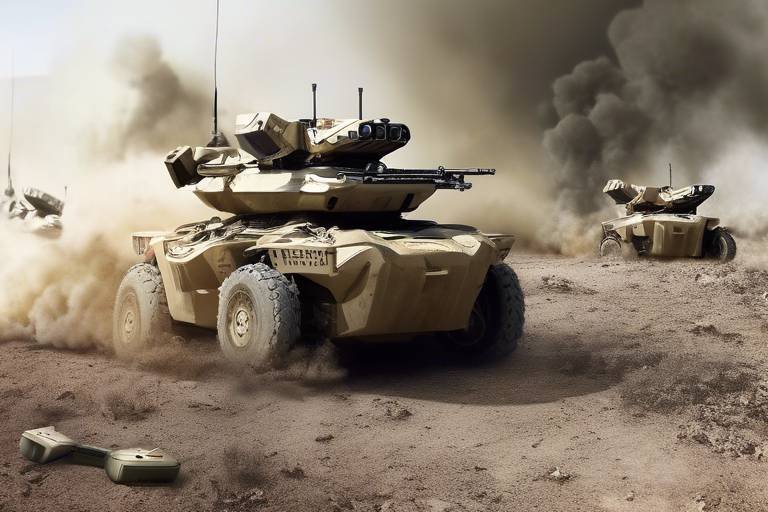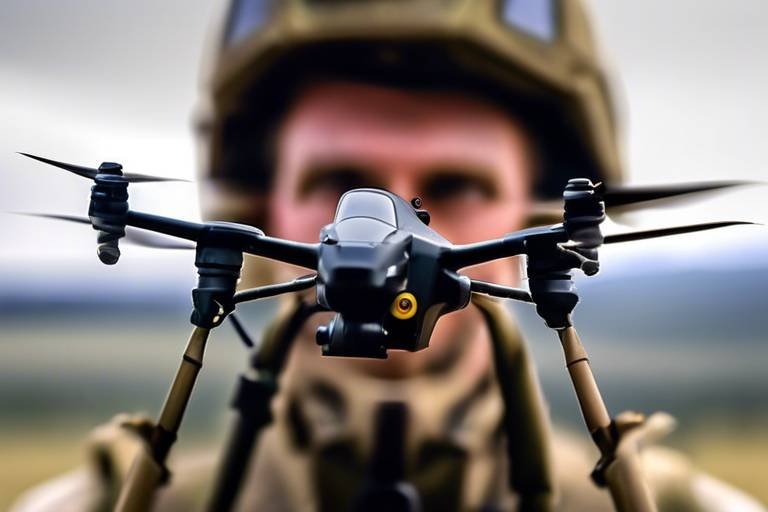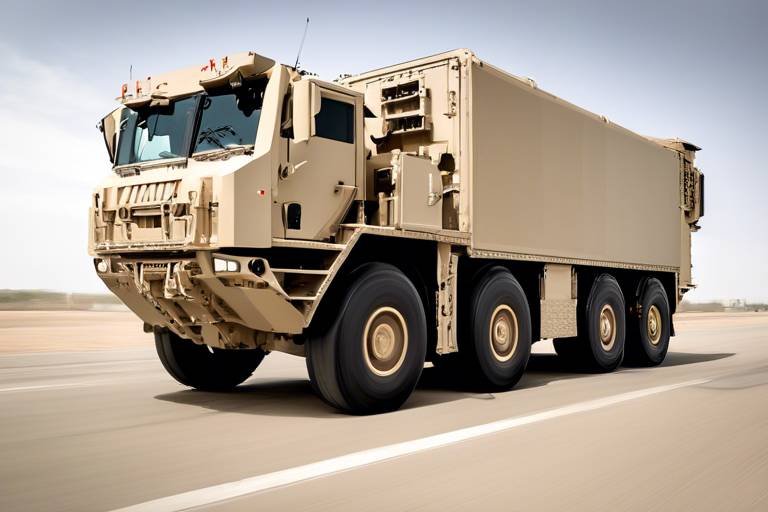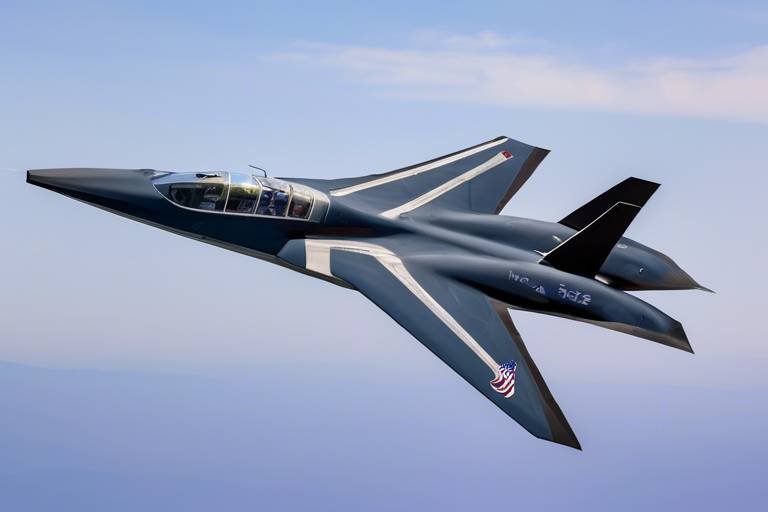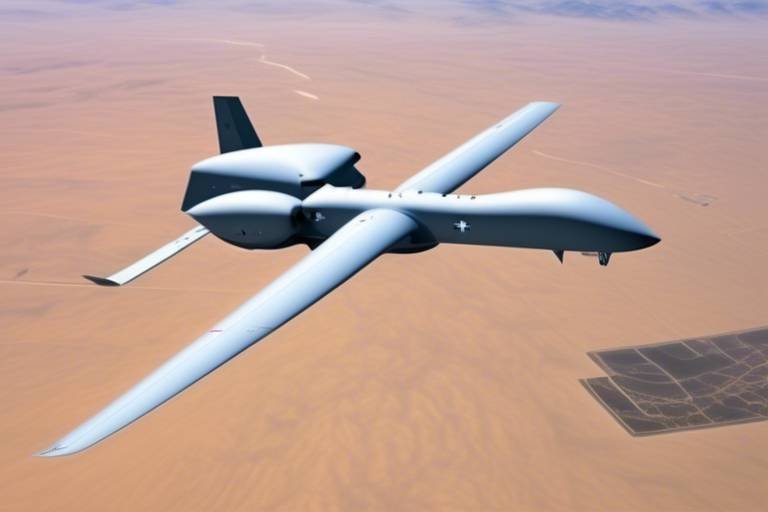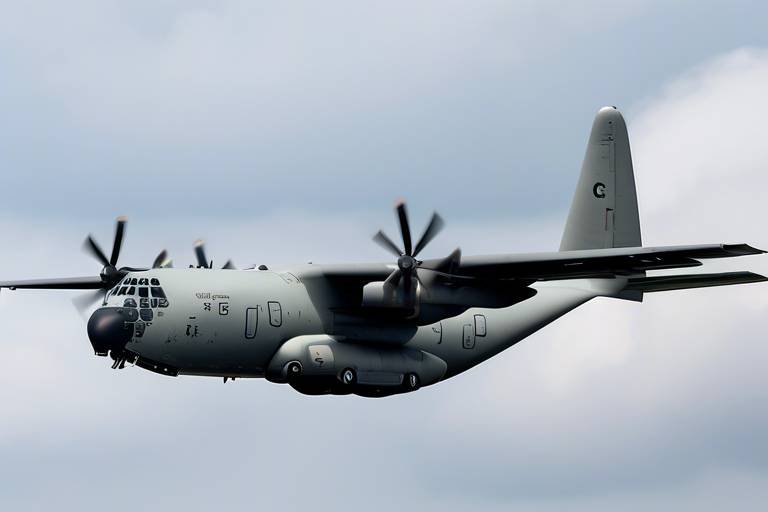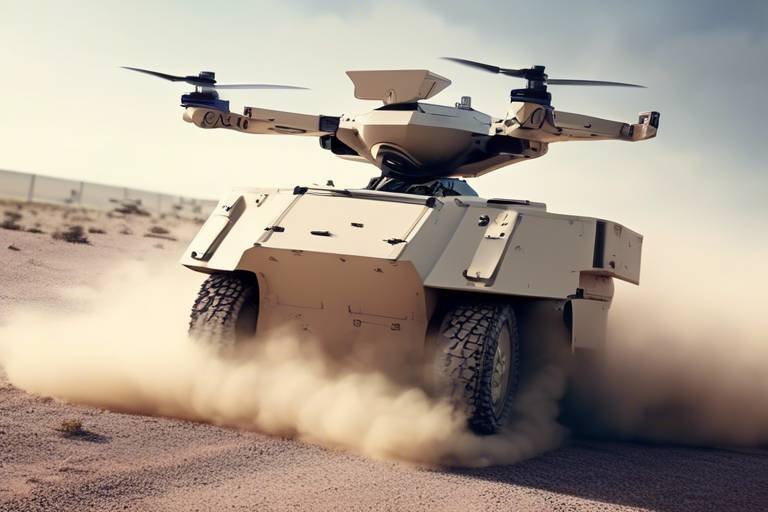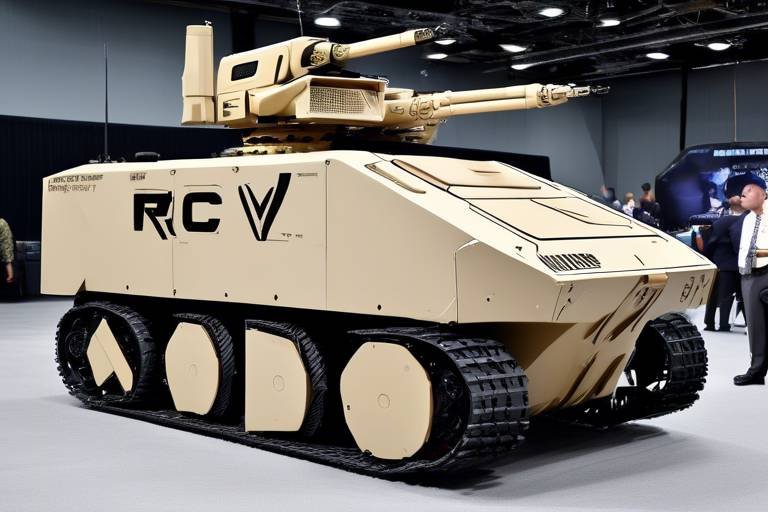The Use of the UGV in Urban Warfare Tactics
In the ever-evolving landscape of modern warfare, Unmanned Ground Vehicles (UGVs) have emerged as game-changers, particularly in the context of urban conflict. Imagine navigating the chaotic streets of a city, where every corner could hide a threat; this is where UGVs come into play. These robotic allies are not just metal boxes on wheels; they are sophisticated machines equipped with cutting-edge technology that can alter the course of military operations. Their integration into urban warfare tactics has opened up a new frontier, allowing for enhanced reconnaissance, reduced risk to personnel, and improved situational awareness.
So, what exactly are UGVs? At their core, they are vehicles that can operate without a human driver on board, controlled remotely or autonomously. They come in various shapes and sizes, from small reconnaissance bots to larger, heavily armored units designed for combat. The technological advancements that have propelled UGVs into the spotlight are nothing short of remarkable. With advancements in artificial intelligence, sensor technology, and robotics, these vehicles can now perform tasks that were once unimaginable.
The deployment of UGVs in urban warfare offers a plethora of tactical advantages. For starters, they significantly enhance reconnaissance capabilities. Think about it: sending a UGV into a potentially hostile environment allows military forces to gather crucial intelligence without putting soldiers in harm's way. This capability not only improves mission planning but also enhances execution, providing real-time data that can be critical in fast-paced combat situations.
When it comes to gathering intelligence, UGVs equipped with advanced sensors are like having a bird's eye view of the battlefield. These vehicles can traverse narrow alleyways and tight spaces that would be challenging for traditional military vehicles. With their ability to gather real-time data, UGVs can provide commanders with a clearer picture of the operational environment. This is particularly vital in urban settings, where visibility can be severely limited.
The integration of cutting-edge sensor technologies further amplifies the capabilities of UGVs. Technologies such as LiDAR and thermal imaging allow these vehicles to operate effectively in diverse urban conditions. For instance, LiDAR can create detailed 3D maps of the terrain, while thermal imaging can detect heat signatures, identifying potential threats even in low visibility. These advancements not only improve reconnaissance but also contribute to better mission planning and execution.
Once data is collected, the next challenge is analyzing it efficiently. UGVs are equipped with sophisticated data processing algorithms that transform raw data into actionable intelligence. This capability is crucial in urban combat scenarios, where timely decision-making can mean the difference between success and failure. By leveraging advanced analytics, military commanders can make informed decisions based on real-time insights.
One of the most significant benefits of UGVs is their ability to minimize the exposure of personnel to danger. In hostile urban environments, soldiers face numerous threats, from snipers to improvised explosive devices (IEDs). By deploying UGVs, military forces can conduct operations while keeping their troops safe. This not only enhances troop safety but also increases the likelihood of mission success.
Despite their numerous advantages, UGVs are not without challenges. Urban warfare presents unique operational hurdles that can hinder their effectiveness. For instance, navigating complex terrain can be a significant issue. Urban environments are often filled with obstacles, such as debris, buildings, and uneven surfaces, which can impede UGV mobility. Addressing these challenges requires innovative solutions and ongoing advancements in technology.
Urban environments can be a maze for UGVs. The intricate layout, combined with potential hazards, makes navigation a complex task. However, research and development in robotics are focusing on improving the navigation capabilities of these vehicles. Innovations such as enhanced GPS systems and advanced obstacle detection algorithms are paving the way for more effective UGV operations in urban settings.
Another significant challenge is maintaining reliable communication with UGVs. In urban settings, signal interference can disrupt control signals, leading to potential operational failures. To combat this issue, military researchers are exploring advanced communication technologies, including mesh networks and satellite-based systems, to ensure that UGVs can remain connected and responsive even in challenging environments.
The future of UGVs in urban warfare is incredibly promising. As technology continues to advance, we can expect to see even greater integration of artificial intelligence (AI) into UGV operations. This will not only enhance their autonomy but also revolutionize decision-making processes in combat scenarios. Imagine UGVs that can analyze a situation and make tactical decisions on their own; the implications for military strategy are profound.
Incorporating AI into UGV operations can significantly enhance their capabilities. With machine learning algorithms, these vehicles can learn from their experiences and improve their performance over time. This evolution could lead to UGVs that are not only capable of executing complex tasks but also adapting to new challenges on the battlefield.
Looking ahead, we may see an increase in collaborative operations between UGVs and aerial drones. The combination of ground and aerial capabilities could provide a comprehensive operational advantage, allowing military forces to gather intelligence and execute missions with unprecedented efficiency. By integrating these technologies, military strategists can develop innovative tactics that leverage the strengths of both platforms.
- What are UGVs used for in urban warfare? UGVs are primarily used for reconnaissance, surveillance, and reducing personnel exposure to danger in hostile environments.
- How do UGVs navigate complex urban terrains? UGVs use advanced sensors and algorithms to detect obstacles and navigate through challenging environments.
- What role does AI play in UGV operations? AI enhances UGV autonomy and decision-making, allowing them to adapt to dynamic combat scenarios.
- Can UGVs work alongside drones? Yes, the integration of UGVs and drones can provide a comprehensive operational advantage in urban warfare.

Introduction to UGVs
Unmanned Ground Vehicles (UGVs) have emerged as a revolutionary force in modern warfare, particularly in the context of urban conflict. These sophisticated machines are designed to operate without a human operator on board, allowing military forces to execute missions with enhanced efficiency and safety. But what exactly are UGVs? In simple terms, they are robotic vehicles that can traverse challenging terrains and perform a variety of tasks, from reconnaissance to logistics support.
The evolution of UGV technology has been nothing short of remarkable. Initially developed for reconnaissance and bomb disposal, today's UGVs are equipped with advanced capabilities that allow them to engage in complex operations. They can be broadly categorized into several types, including:
- Reconnaissance UGVs: Designed primarily for surveillance and intelligence gathering.
- Combat UGVs: Equipped with weaponry to engage in direct combat.
- Logistics UGVs: Used for transporting supplies and equipment in the field.
Technological advancements, particularly in areas like artificial intelligence, machine learning, and sensor technology, have propelled the integration of UGVs into military operations. These innovations allow UGVs to process vast amounts of data in real-time, navigate complex urban environments, and even make autonomous decisions. Imagine a UGV equipped with thermal imaging sensors that can detect enemy movements at night, all while relaying crucial information back to command centers. This capability not only enhances operational effectiveness but also significantly reduces risks to human personnel.
As we delve deeper into the tactical advantages of UGVs in urban warfare, it's essential to recognize their role in shaping the future of military strategies. The seamless integration of UGVs into military operations is not just a trend; it's a paradigm shift that will redefine how conflicts are fought in densely populated areas. With the promise of increased safety and efficiency, UGVs are set to become an indispensable part of the modern battlefield.
- What are the primary functions of UGVs in urban warfare? UGVs are primarily used for reconnaissance, logistics, and combat support, allowing military units to operate more safely and effectively in urban environments.
- How do UGVs enhance troop safety? By taking on dangerous tasks such as surveillance and explosive ordnance disposal, UGVs reduce the exposure of personnel to potential threats.
- What technological advancements have contributed to the effectiveness of UGVs? Key advancements include improved sensor technologies, artificial intelligence, and enhanced data processing capabilities, which allow UGVs to operate autonomously and make real-time decisions.

Tactical Advantages of UGVs
The deployment of Unmanned Ground Vehicles (UGVs) in urban warfare is not just a trend; it represents a profound shift in military strategy that brings a multitude of tactical advantages to the battlefield. Imagine a scenario where soldiers can conduct operations without exposing themselves to the immediate dangers of urban combat. UGVs make this possible by providing enhanced reconnaissance capabilities, reducing personnel risk, and improving situational awareness. These advantages are crucial in densely populated environments where every decision can mean the difference between success and failure.
One of the most significant benefits of UGVs is their enhanced reconnaissance capabilities. Equipped with state-of-the-art sensors, these vehicles can gather real-time intelligence in complex urban settings. For example, they can navigate narrow alleyways, traverse rubble-strewn streets, and even operate in complete darkness, all while relaying information back to command units. This capability allows for better mission planning and execution, as commanders can make informed decisions based on accurate, up-to-the-minute data.
When it comes to reconnaissance, UGVs shine. The integration of advanced sensor technologies, such as LiDAR and thermal imaging, empowers these vehicles to operate effectively in various urban conditions. For instance, LiDAR can create detailed 3D maps of the environment, revealing potential hiding spots for enemy combatants, while thermal imaging can detect heat signatures, making it easier to spot individuals in low-visibility situations.
Moreover, the data collected by UGVs can be processed and analyzed efficiently, enhancing decision-making processes. Advanced algorithms can sift through the massive amounts of data generated, identifying patterns and anomalies that might otherwise go unnoticed. This capability is particularly vital in urban combat scenarios where the environment is constantly changing and the dynamics of the battlefield can shift in an instant.
Another critical advantage of UGVs is the reduction of risk to personnel. In urban warfare, soldiers are often placed in perilous situations, exposed to enemy fire and ambushes. By deploying UGVs to scout ahead or engage in direct action, military forces can significantly minimize the exposure of troops to danger. This not only enhances troop safety but also increases the likelihood of mission success.
Consider this: in a typical urban engagement, a UGV can be sent into a potentially hostile area to assess threats, gather intelligence, and even deliver supplies, all while the soldiers remain at a safe distance. This strategic use of UGVs allows for a more calculated approach to warfare, where human lives are prioritized without sacrificing operational effectiveness.
In summary, the tactical advantages of UGVs in urban warfare are manifold. They offer enhanced reconnaissance, improved situational awareness, and a significant reduction in risk to personnel. As technology continues to evolve, the role of UGVs in military operations will only expand, making them an indispensable asset on the modern battlefield.
- What are UGVs? Unmanned Ground Vehicles (UGVs) are robotic vehicles that can operate without human intervention, often used in military applications for reconnaissance and combat support.
- How do UGVs enhance reconnaissance? UGVs are equipped with advanced sensors that allow them to gather real-time intelligence, navigate complex terrains, and operate in various environmental conditions.
- What are the safety benefits of using UGVs? By deploying UGVs, military forces can reduce the exposure of personnel to dangerous situations, thereby enhancing troop safety and mission success.
- What technologies are integrated into UGVs? UGVs utilize technologies such as LiDAR, thermal imaging, and sophisticated data processing algorithms to improve operational capabilities.

Enhanced Reconnaissance
In the chaotic landscape of urban warfare, where every alley and rooftop can hide potential threats, the need for accurate and timely intelligence is paramount. This is where Unmanned Ground Vehicles (UGVs) shine, equipped with advanced reconnaissance capabilities that dramatically enhance situational awareness for military forces. Imagine sending a robotic scout into a dangerous neighborhood instead of risking a soldier's life—this is the new reality of modern warfare.
UGVs are outfitted with a variety of sophisticated sensors that enable them to gather real-time intelligence in environments that are often too risky for human operatives. These sensors include LiDAR for precise mapping, thermal imaging for detecting heat signatures, and high-definition cameras for visual reconnaissance. The integration of these technologies allows UGVs to operate effectively under various conditions, whether it’s the blinding glare of daylight or the pitch darkness of night.
The ability of UGVs to perform reconnaissance in urban settings is not just about collecting data; it’s about transforming that data into actionable intelligence. For instance, a UGV equipped with thermal imaging can identify hidden enemy positions, while LiDAR can create a 3D map of the terrain, revealing potential ambush sites or escape routes. This real-time intelligence is invaluable for mission planning and execution, allowing commanders to make informed decisions based on the latest information.
Moreover, the data gathered by UGVs can be processed using advanced algorithms that filter out irrelevant information and highlight critical insights. This capability significantly enhances the decision-making process in high-stakes situations. The result? Military operations that are not only more efficient but also safer for personnel on the ground. The synergy between UGVs and their sensor technologies is a game-changer in urban warfare.
To illustrate the impact of UGVs on reconnaissance, consider the following table that compares traditional reconnaissance methods with UGV capabilities:
| Feature | Traditional Reconnaissance | UGV Reconnaissance |
|---|---|---|
| Risk to Personnel | High | Low |
| Data Collection Speed | Moderate | High |
| Environmental Adaptability | Limited | Extensive |
| Real-time Intelligence | Delayed | Immediate |
In conclusion, the enhanced reconnaissance capabilities of UGVs not only provide a tactical edge in urban warfare but also redefine how military operations are conducted. As technology continues to evolve, we can expect UGVs to become even more integral to reconnaissance efforts, paving the way for safer, more effective military strategies in densely populated environments.
- What are UGVs? Unmanned Ground Vehicles (UGVs) are robotic vehicles that are operated remotely or autonomously, used primarily for military reconnaissance and operations.
- How do UGVs enhance reconnaissance? They provide real-time data collection through advanced sensors, reducing risk to personnel and improving situational awareness.
- What types of sensors are used in UGVs? Common sensors include LiDAR, thermal imaging, and high-definition cameras, which help in gathering detailed intelligence.
- Can UGVs operate in adverse conditions? Yes, UGVs are designed to adapt to various environmental conditions, making them effective in diverse urban settings.

Sensor Technologies
The realm of urban warfare is dynamic and fraught with challenges, making the role of in Unmanned Ground Vehicles (UGVs) absolutely vital. These technologies are not just accessories; they are the lifeblood of effective reconnaissance in complex environments. UGVs are equipped with a variety of sensors that allow them to navigate and gather crucial data in real-time, which is essential for mission success. Imagine a soldier on the ground, relying on outdated maps and limited visibility, versus a UGV that can 'see' through walls and darkness. This is the transformative power of advanced sensor technologies.
One of the most significant advancements in sensor technology is the use of LiDAR (Light Detection and Ranging). This technology utilizes laser light to measure distances and create detailed 3D maps of the terrain. In urban settings, where buildings and other structures can obstruct visibility, LiDAR provides a comprehensive overview, allowing military planners to devise strategies that are both effective and safe. Additionally, LiDAR can penetrate through foliage and other obstacles, offering a clearer picture of the battlefield.
Another critical technology is thermal imaging. This sensor detects heat emitted by objects, which is particularly useful in low-light conditions. In an urban environment, where shadows and darkness can create perilous situations, thermal imaging allows UGVs to identify potential threats, such as enemy combatants or hidden explosives, even in complete darkness. The ability to 'see' heat signatures can mean the difference between life and death for personnel on the ground.
Furthermore, UGVs are increasingly incorporating multi-spectral imaging capabilities. This technology combines data from various wavelengths of light to provide a more comprehensive view of the environment. By analyzing different spectra, UGVs can detect materials and substances that are invisible to the naked eye, such as chemical agents or hidden weapons caches. This capability enhances situational awareness and allows for more informed decision-making in real-time.
To effectively utilize these sensor technologies, UGVs also rely on sophisticated data analysis algorithms. These algorithms process the vast amounts of data collected by the sensors, filtering out noise and highlighting actionable intelligence. The ability to quickly analyze and interpret this data is crucial in urban warfare, where conditions can change rapidly and time is often of the essence. For instance, if a UGV identifies a potential threat, the data analysis can provide commanders with immediate insights, allowing them to respond swiftly and effectively.
In summary, the integration of advanced sensor technologies into UGVs is revolutionizing urban warfare tactics. With tools like LiDAR, thermal imaging, and multi-spectral imaging, these vehicles are not merely machines; they are sophisticated platforms capable of transforming the battlefield. The combination of real-time data collection and advanced data processing empowers military forces to make informed decisions, reduce risks, and ultimately enhance mission success in the chaotic environments of urban warfare.
- What are UGVs? Unmanned Ground Vehicles (UGVs) are robotic systems designed to operate on the ground without a human operator on board, often used for reconnaissance, surveillance, and combat support.
- How do sensor technologies enhance UGV capabilities? Sensor technologies like LiDAR and thermal imaging allow UGVs to gather critical data in real-time, improving situational awareness and mission planning.
- What challenges do UGVs face in urban warfare? UGVs encounter challenges such as complex terrain navigation, communication disruptions, and the need for human oversight in densely populated environments.
- What is the future of UGVs in military operations? The future looks promising with advancements in AI and robotics, which may lead to greater autonomy and collaborative operations with aerial drones.

Data Analysis and Processing
In the fast-paced world of urban warfare, the ability to swiftly analyze and process data can mean the difference between success and failure. Unmanned Ground Vehicles (UGVs) are equipped with advanced data collection systems that gather a plethora of information during missions. This data isn't just numbers and images; it's a treasure trove of actionable insights that can significantly enhance decision-making processes on the battlefield.
When UGVs deploy into urban environments, they utilize sophisticated sensors to capture real-time data. This data includes everything from surveillance footage to environmental readings, which are crucial for understanding the operational landscape. The challenge, however, lies in converting this raw data into something meaningful. That's where advanced data processing algorithms come into play. These algorithms sift through vast amounts of information, identifying patterns and anomalies that human operators might miss.
Imagine a UGV navigating through a chaotic cityscape, collecting data at every turn. The vehicle's onboard systems analyze this data in real-time, providing commanders with up-to-the-minute intelligence. For instance, if a UGV detects unusual movement in a specific area, it can alert troops to potential threats, allowing them to adjust their strategies on the fly. This capability not only enhances situational awareness but also empowers military leaders to make informed decisions quickly.
To illustrate the impact of data analysis in urban warfare, consider the following table that outlines key benefits:
| Benefit | Description |
|---|---|
| Real-time Intelligence | Immediate insights into enemy positions and movements. |
| Pattern Recognition | Identification of trends and behaviors that inform tactical decisions. |
| Resource Allocation | Data-driven decisions on troop deployment and support. |
| Risk Assessment | Evaluating potential threats based on gathered intelligence. |
Moreover, the integration of machine learning techniques into data processing systems allows UGVs to continuously improve their analytical capabilities. As they gather more data, these systems learn from past encounters, refining their algorithms to become more accurate over time. This self-improving aspect is akin to how we learn from our experiences; the more we know, the better we get at making decisions.
In conclusion, the role of data analysis and processing in urban warfare cannot be overstated. UGVs are not just robotic vehicles; they are intelligent systems that provide critical insights and enhance operational effectiveness. As technology continues to evolve, the potential for UGVs to revolutionize urban combat tactics will only grow, making them indispensable assets on the modern battlefield.
- What are UGVs? Unmanned Ground Vehicles are robotic systems that operate on the ground without a human operator on board, often used in military applications.
- How do UGVs enhance reconnaissance capabilities? UGVs are equipped with advanced sensors that allow them to gather real-time intelligence and improve situational awareness.
- What challenges do UGVs face in urban environments? UGVs encounter issues related to terrain navigation, communication disruptions, and the need for human oversight.
- How is data processed in UGVs? UGVs use sophisticated algorithms to analyze data in real-time, providing actionable intelligence to military commanders.
- What is the future of UGVs in urban warfare? The future looks promising with advancements in AI and robotics, enhancing the capabilities and effectiveness of UGVs in combat scenarios.

Risk Reduction for Personnel
The utilization of Unmanned Ground Vehicles (UGVs) in urban warfare represents a significant leap forward in minimizing risks to military personnel. In the chaotic and unpredictable environment of urban conflict, where threats can emerge from any direction, UGVs serve as a crucial buffer between soldiers and potential dangers. Imagine a scenario where troops are advancing through a densely populated area; the last thing they want is to be exposed to enemy fire or hidden explosives. This is where UGVs come into play, acting as the first line of defense.
One of the primary advantages of deploying UGVs is their ability to conduct reconnaissance missions without putting human lives at risk. For instance, a UGV can be sent into a suspicious area to scout for threats, such as improvised explosive devices (IEDs) or enemy combatants. By doing so, it allows troops to gather vital intelligence while maintaining a safe distance. This not only enhances the operational effectiveness of military units but also significantly reduces the likelihood of casualties.
Furthermore, UGVs can be equipped with advanced technologies that enhance their effectiveness in risk reduction. For example, many UGVs are fitted with explosive ordnance disposal (EOD) tools, enabling them to neutralize threats from a safe distance. This capability is particularly valuable in urban settings where the risk of collateral damage is high. By using UGVs for such operations, the military can mitigate risks not only to personnel but also to civilians in the vicinity.
Additionally, the psychological impact of using UGVs cannot be overlooked. Soldiers operating in high-stress environments often face significant mental strain. Knowing that a UGV is handling dangerous tasks can provide peace of mind, allowing them to focus on their primary objectives. This aspect of risk reduction is just as crucial as the physical safety provided by these machines.
However, it is essential to recognize that while UGVs significantly reduce risk, they are not a complete substitute for human judgment and intervention. The presence of a human operator is still necessary to make critical decisions, especially in unpredictable urban landscapes. The integration of UGVs into military operations should be viewed as a complementary strategy that enhances the safety and effectiveness of personnel on the ground.
- What are UGVs? Unmanned Ground Vehicles (UGVs) are robotic systems designed to operate on the ground without a human operator on board. They are used in various military operations, particularly in urban warfare.
- How do UGVs reduce risks to personnel? UGVs can perform reconnaissance and explosive disposal tasks, allowing soldiers to stay at a safe distance from potential threats, thus minimizing the risk of casualties.
- What technologies are used in UGVs? UGVs are equipped with advanced sensors, cameras, and EOD tools, which enhance their operational capabilities in urban environments.
- Are UGVs completely autonomous? While UGVs can operate independently, human oversight is still necessary for critical decision-making, especially in complex urban settings.

Operational Challenges of UGVs
While Unmanned Ground Vehicles (UGVs) have revolutionized urban warfare, they are not without their operational challenges. As military forces increasingly rely on these advanced machines, understanding the difficulties they face is crucial for maximizing their effectiveness in combat scenarios. One of the most significant challenges is terrain navigation. Urban environments are notoriously complex, filled with obstacles such as buildings, vehicles, and debris that can hinder UGV mobility. Unlike open fields where movement is relatively straightforward, cities present a labyrinth of potential hazards. UGVs must be equipped with sophisticated navigation systems to recognize and adapt to these challenges, ensuring they can traverse the urban landscape effectively.
Another pressing issue is communication and control limitations. In densely populated areas, maintaining a stable connection with UGVs can be problematic. Urban structures can interfere with signals, leading to communication disruptions that might compromise mission success. Imagine trying to send a text message in a crowded subway station—similar interference can occur with UGVs, making it difficult for operators to control them remotely. To combat this, military researchers are exploring advanced communication technologies, such as mesh networks and satellite links, to enhance connectivity even in challenging environments.
Moreover, the need for human oversight remains a critical aspect of UGV operations. While these vehicles are becoming increasingly autonomous, they still require human operators to make strategic decisions, especially in high-stakes situations. This necessity for oversight can slow down response times and complicate operational dynamics. Military forces must strike a balance between automation and human intervention to ensure that UGVs are used to their full potential without compromising safety or effectiveness.
To summarize, the operational challenges of UGVs in urban warfare include:
- Terrain Navigation Issues: Complex urban landscapes can impede mobility.
- Communication Disruptions: Signal interference can hinder control and coordination.
- Need for Human Oversight: Autonomy is limited, requiring human operators for critical decisions.
Addressing these challenges is essential for the successful integration of UGVs into military operations. As technology continues to advance, solutions to these issues will likely emerge, paving the way for more effective and reliable UGV deployment in urban warfare.
- What are UGVs? Unmanned Ground Vehicles (UGVs) are robotic systems designed to operate on the ground without human operators on board, often used in military applications.
- What are the main challenges faced by UGVs in urban warfare? The primary challenges include terrain navigation issues, communication disruptions, and the need for human oversight.
- How can UGVs improve safety for military personnel? By performing reconnaissance and engaging in combat scenarios without putting soldiers directly in harm's way, UGVs significantly reduce risk to personnel.
- What technologies are used to enhance UGV navigation? Advanced sensor technologies, such as LiDAR and GPS, are commonly used to improve navigation in complex urban environments.

Terrain Navigation Issues
Urban environments are a double-edged sword for Unmanned Ground Vehicles (UGVs). On one hand, they provide a rich tapestry of challenges that can be navigated with precision; on the other, they present intricate obstacles that can impede UGV mobility. Imagine trying to maneuver a tank through a crowded city street filled with cars, pedestrians, and unpredictable terrain. It's not just about moving forward; it's about making real-time decisions in a dynamic environment.
The complexity of urban terrain includes a variety of factors such as uneven surfaces, narrow alleyways, and obstacles like debris and infrastructure. Each of these elements can significantly hinder a UGV's ability to traverse effectively. For instance, a vehicle designed for open fields may struggle to navigate the tight corners of a city block or the uneven pavement of a side street. This limitation is particularly critical during high-stakes missions where speed and agility are paramount.
To tackle these challenges, engineers and military strategists are exploring several solutions:
- Advanced Mobility Systems: Incorporating advanced suspension and wheel designs that allow UGVs to adapt to uneven surfaces.
- Terrain Mapping: Utilizing sophisticated mapping technologies to create 3D models of urban environments, which can inform UGV navigation systems.
- Real-time Data Processing: Implementing algorithms that allow UGVs to analyze their surroundings and make quick decisions about the best route to take.
Moreover, the integration of sensor technologies plays a crucial role in overcoming navigation issues. For example, UGVs equipped with LiDAR can generate precise maps of their surroundings, allowing them to identify obstacles and plan their paths accordingly. This capability is essential for ensuring that UGVs can operate effectively in complex urban settings.
Despite these advancements, the reality is that UGVs still require human oversight to navigate unpredictable urban landscapes successfully. Operators need to be able to step in and take control when the technology encounters a situation it cannot handle. This need for human intervention raises the question: how do we balance autonomy with the necessity of human decision-making in critical situations?
In conclusion, while UGVs hold great promise for urban warfare, their effectiveness is contingent upon overcoming terrain navigation challenges. As technology continues to evolve, there is hope that these vehicles will become more adept at navigating the urban jungle, ultimately enhancing their operational capabilities and the safety of military personnel.
- What are UGVs? Unmanned Ground Vehicles (UGVs) are robotic systems designed to operate on the ground without a human operator on board. They are used for various military applications, particularly in urban warfare.
- What are the main challenges UGVs face in urban environments? UGVs encounter issues such as complex terrain navigation, communication disruptions, and the need for human oversight during operations.
- How can UGVs navigate difficult urban terrains? UGVs can utilize advanced mobility systems, terrain mapping technologies, and real-time data processing to enhance their navigation capabilities.
- Will UGVs replace human soldiers in urban warfare? While UGVs can reduce risk to personnel, they are not expected to fully replace human soldiers. Instead, they serve as a complementary force, enhancing operational effectiveness.

Communication and Control Limitations
In the dynamic and often chaotic environment of urban warfare, pose significant challenges for Unmanned Ground Vehicles (UGVs). While these robotic systems offer numerous tactical advantages, their effectiveness can be severely hampered by the complexities of urban infrastructure. Imagine trying to send a text message from a busy subway station—it's not just about the message itself, but also about the barriers that can disrupt the signal. Similarly, UGVs face a myriad of obstacles that can interfere with their operational capabilities.
One of the primary issues is signal interference. Urban areas are typically filled with tall buildings, dense materials, and various electronic devices that can disrupt communication signals. This interference can lead to a loss of control over the UGV, making it difficult for operators to send commands or receive data. For instance, if a UGV is navigating through a narrow alleyway, the signal might drop, leaving the vehicle in a precarious situation. This unpredictability can lead to operational delays and increased risk during missions.
Moreover, the reliance on traditional communication methods can be a double-edged sword. If the UGV's communication system is based on radio frequency (RF), it may be vulnerable to jamming or hacking attempts. With the rise of cyber warfare, adversaries can exploit these vulnerabilities to disrupt UGV operations. To illustrate this point, consider the following table that outlines common communication challenges faced by UGVs in urban settings:
| Challenge | Description | Potential Solutions |
|---|---|---|
| Signal Interference | Urban structures disrupt RF signals, leading to communication loss. | Utilizing advanced signal processing techniques. |
| Cyber Vulnerabilities | Risk of jamming or hacking of communication systems. | Implementing encryption and secure communication protocols. |
| Line of Sight Issues | Obstacles can block direct communication between UGVs and operators. | Employing relay systems or mesh networks. |
To mitigate these challenges, military strategists are exploring various technological advancements. For example, the development of mesh networking allows multiple UGVs to communicate with each other, creating a more resilient communication network. This way, if one UGV loses its signal, others can relay information, ensuring that operational continuity is maintained. It's akin to a group of friends passing a message along in a crowded room—if one can't hear, another can pick it up and share it.
Additionally, advances in artificial intelligence are paving the way for more autonomous UGV operations. With AI, UGVs can make real-time decisions and adapt to changing conditions without constant human oversight. This reduces the dependency on communication links and allows for more effective operations in environments where communication is unreliable. However, the integration of AI also raises questions about the level of human control necessary in critical situations.
In conclusion, while UGVs are revolutionizing urban warfare, addressing the is crucial for maximizing their potential. By investing in innovative technologies and strategies, military forces can enhance the reliability and effectiveness of these unmanned systems, ultimately leading to safer and more successful missions.
- What are the main communication challenges for UGVs in urban warfare? The main challenges include signal interference from urban structures, cyber vulnerabilities, and line of sight issues.
- How can these challenges be mitigated? Solutions include using advanced signal processing, implementing secure communication protocols, and employing mesh networking.
- What role does AI play in overcoming communication limitations? AI enhances UGV autonomy, allowing them to make real-time decisions and adapt to changing conditions, which reduces reliance on constant communication.

Future Implications of UGVs
The future of Unmanned Ground Vehicles (UGVs) in urban warfare is not just a fleeting trend; it’s a transformative shift that is set to redefine military strategies in the coming years. As technology continues to advance at an unprecedented pace, the integration of UGVs into military operations appears to be more promising than ever. Imagine a battlefield where robots and artificial intelligence (AI) work hand-in-hand with human soldiers, reducing casualties and enhancing operational efficiency. This is not science fiction; it's on the horizon.
One of the most exciting aspects of UGV evolution is their potential integration with AI technologies. The incorporation of AI can significantly enhance the autonomy of UGVs, allowing them to make real-time decisions based on the data they gather. For instance, during a reconnaissance mission, an AI-equipped UGV could analyze the terrain, identify potential threats, and even suggest optimal routes for ground troops. This level of operational efficiency can be a game-changer, especially in densely populated urban environments where every second counts.
Moreover, the collaboration between UGVs and aerial drones is another frontier that military strategists are keen to explore. Imagine a scenario where drones provide aerial surveillance while UGVs navigate the streets below, creating a comprehensive situational awareness network. This synergy could lead to more effective mission planning and execution, as both platforms would share data in real time, allowing for coordinated actions that can adapt to changing conditions on the ground.
However, with these advancements come challenges that need addressing. For example, the integration of AI into UGVs raises questions about ethical considerations and the potential for autonomous decision-making in combat scenarios. Military leaders must navigate these ethical waters carefully to ensure that technology enhances human judgment rather than replaces it. Additionally, as UGVs become more autonomous, the need for robust cybersecurity measures becomes paramount to prevent adversaries from hacking into these systems.
As we look to the future, we can anticipate several key trends in UGV development:
- Increased Autonomy: UGVs will likely operate with less human intervention, relying on AI to navigate complex environments.
- Enhanced Communication Systems: Future UGVs will feature advanced communication technologies, reducing the impact of signal interference.
- Interoperability: UGVs will increasingly work in tandem with other military assets, such as drones and manned vehicles, creating a more cohesive battlefield strategy.
In summary, the implications of UGVs in urban warfare are vast and varied. As these technologies continue to evolve, they promise to enhance not only the effectiveness of military operations but also the safety of personnel on the ground. The future of warfare is indeed being shaped by these unmanned systems, and it’s an exciting time to witness this transformation.
Q: What are UGVs?
A: Unmanned Ground Vehicles (UGVs) are robotic vehicles that operate on the ground without a human operator onboard. They can be used for various military applications, including reconnaissance, surveillance, and logistics.
Q: How do UGVs enhance military operations?
A: UGVs enhance military operations by providing real-time intelligence, reducing the risk to personnel, and improving situational awareness in complex environments.
Q: What role does AI play in the future of UGVs?
A: AI will enhance the autonomy of UGVs, allowing them to make real-time decisions and improve their operational efficiency in urban warfare scenarios.
Q: Can UGVs work with drones?
A: Yes, the future of urban warfare will likely see increased collaboration between UGVs and aerial drones, creating a more integrated approach to military operations.

Integration with AI Technologies
The incorporation of artificial intelligence (AI) into Unmanned Ground Vehicles (UGVs) is not just a trend; it's a game-changer in urban warfare tactics. Imagine a battlefield where machines can think, learn, and adapt in real-time, making decisions faster than any human could. This integration enhances the UGVs' operational capabilities, allowing them to navigate complex environments and respond to threats with unprecedented efficiency.
AI technologies empower UGVs to analyze vast amounts of data from various sensors, enabling them to identify patterns and predict enemy movements. For example, a UGV equipped with AI can process inputs from LiDAR, thermal imaging, and other sensors to create a detailed map of the urban terrain. This capability allows commanders to visualize the battlefield better and make informed decisions. The fusion of AI with UGVs can significantly reduce the time needed for reconnaissance missions, thereby increasing operational tempo.
Moreover, AI enhances the autonomy of UGVs. With advanced algorithms, these vehicles can operate independently, performing tasks such as surveillance, logistics support, and even engaging targets when necessary. This autonomy is crucial in urban warfare, where the dynamics can change rapidly, and human operators may not always be able to react in time. Imagine a UGV that can autonomously navigate through a maze of buildings, avoiding obstacles and making tactical decisions on the fly. This level of operational independence could be a decisive factor in combat scenarios.
However, the integration of AI also raises important considerations. As UGVs become more autonomous, the question of human oversight becomes critical. While AI can enhance decision-making, it is essential to maintain a balance between machine autonomy and human control to prevent unintended consequences. Establishing clear rules of engagement and ethical guidelines for AI deployment in warfare is paramount to ensure responsible usage.
In conclusion, the integration of AI technologies into UGV operations is set to revolutionize urban warfare. The combination of enhanced data analysis, increased autonomy, and improved decision-making capabilities offers military forces a significant edge in combat. As we look to the future, it’s essential to navigate the challenges and ethical considerations that come with this technological evolution.
- What are UGVs? Unmanned Ground Vehicles (UGVs) are robotic systems designed to operate on the ground without a human operator onboard. They are used in various military applications, including reconnaissance, logistics, and combat support.
- How does AI improve UGV performance? AI enhances UGV performance by enabling real-time data analysis, autonomous navigation, and decision-making, allowing them to adapt to changing battlefield conditions quickly.
- What are the challenges of using UGVs in urban warfare? UGVs face challenges such as complex terrain navigation, communication disruptions, and the need for human oversight to ensure ethical engagement in combat scenarios.
- Will UGVs replace human soldiers? While UGVs can perform many tasks, they are designed to assist human soldiers rather than replace them. The integration of UGVs aims to enhance troop safety and effectiveness in combat.

Collaborative Operations with Drones
As the battlefield evolves, so does the technology that shapes it. The integration of Unmanned Ground Vehicles (UGVs) with drones is not just a futuristic concept; it is becoming a reality in modern urban warfare. Imagine a scenario where ground units equipped with UGVs are working in tandem with aerial drones, creating a seamless flow of information and operational efficiency. This collaboration can significantly enhance the effectiveness of military strategies in densely populated environments.
The synergy between UGVs and drones can be likened to a well-rehearsed dance, where each partner plays a crucial role. Drones can provide a bird's-eye view of the battlefield, capturing real-time data and relaying it to ground units. This capability allows UGVs to navigate complex urban landscapes more effectively. For instance, while a drone scouts a potential threat from above, the UGV can maneuver through narrow alleyways, ready to engage or gather intelligence without putting personnel at risk.
Moreover, the combination of these technologies can lead to enhanced situational awareness. Drones equipped with high-resolution cameras and thermal imaging can detect hidden threats that UGVs might miss. This is especially vital in urban warfare, where enemies can easily blend into the civilian population. By having drones relay this critical information back to UGVs, military forces can make informed decisions swiftly, reducing the risk of collateral damage and improving mission outcomes.
However, this collaboration is not without its challenges. Effective communication between UGVs and drones is paramount. Both systems must be able to share data in real-time, which requires robust communication networks. Any disruption could lead to catastrophic failures in mission execution. Therefore, ongoing advancements in communication technologies are essential to ensure that these systems can operate cohesively.
In summary, the collaborative operations between UGVs and drones represent a significant leap forward in urban warfare tactics. As these technologies continue to evolve, we can expect to see even greater integration, leading to more sophisticated and effective military strategies. The future of warfare lies in the ability to harness the strengths of both ground and aerial assets, creating a multi-dimensional approach to conflict.
- What are UGVs? Unmanned Ground Vehicles (UGVs) are robotic systems designed to operate on the ground without human intervention, often used in military applications.
- How do UGVs enhance urban warfare tactics? UGVs provide enhanced reconnaissance, reduce risks to personnel, and improve situational awareness in complex urban environments.
- What role do drones play in urban warfare? Drones offer aerial surveillance and real-time data transmission, which can significantly enhance the effectiveness of ground operations conducted by UGVs.
- What are the challenges of integrating UGVs and drones? Key challenges include ensuring reliable communication between systems and addressing potential navigation issues in complex urban terrains.
- What is the future of UGV and drone collaboration? The future looks promising, with advancements in AI and communication technologies expected to enhance the integration and functionality of these systems in urban warfare.
Frequently Asked Questions
- What are Unmanned Ground Vehicles (UGVs)?
Unmanned Ground Vehicles, or UGVs, are robotic systems designed to operate on the ground without a human operator on board. They can be used for various military applications, particularly in urban warfare, where they provide enhanced reconnaissance, reduce risks to personnel, and improve situational awareness.
- How do UGVs enhance reconnaissance in urban environments?
UGVs come equipped with advanced sensors, such as LiDAR and thermal imaging, that allow them to gather real-time intelligence in complex urban settings. This capability significantly improves mission planning and execution by providing commanders with actionable insights about the battlefield.
- What are the primary benefits of using UGVs in military operations?
The main benefits of deploying UGVs include enhanced reconnaissance capabilities, reduced risk to personnel, improved situational awareness, and the ability to operate in hazardous environments without endangering human lives. These advantages make UGVs invaluable in modern urban warfare.
- What operational challenges do UGVs face in urban warfare?
Despite their advantages, UGVs encounter several operational challenges, including navigating complex urban terrains, maintaining reliable communication in signal-interfered environments, and requiring human oversight for effective operation. Addressing these challenges is crucial for maximizing their effectiveness.
- How does terrain affect UGV mobility?
Urban environments present unique challenges for UGV mobility due to obstacles like buildings, vehicles, and uneven surfaces. These factors can hinder their movement, making it essential to develop better navigation solutions that allow UGVs to maneuver effectively in such settings.
- What role does AI play in the future of UGVs?
Artificial Intelligence (AI) is set to revolutionize UGV operations by enhancing their autonomy and decision-making capabilities. With AI integration, UGVs can analyze data in real-time, adapt to changing environments, and make informed decisions with minimal human intervention, significantly improving their operational efficiency.
- Will UGVs collaborate with drones in future urban warfare?
Yes, the future of urban warfare is likely to see increased collaboration between UGVs and aerial drones. This integration can provide comprehensive situational awareness and improved tactical advantages, as both technologies complement each other in surveillance, reconnaissance, and combat operations.



